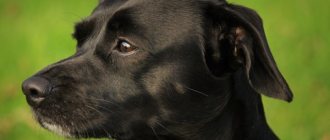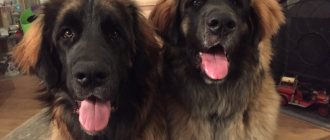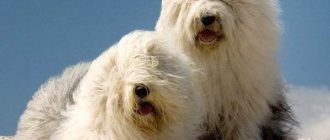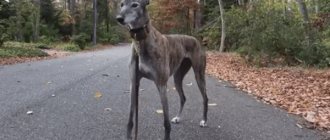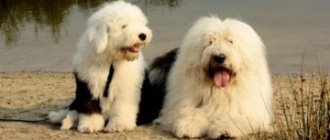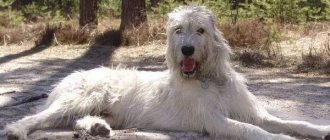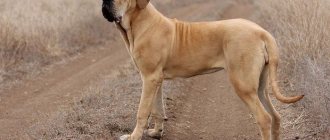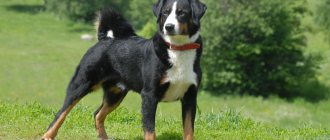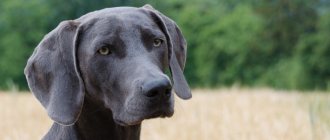Description of the Bloodhound breed
Popularity 233rd place among 263 dog breeds
Lifespan:
10-12 years
Breed group:
Hounds
Height:
males: 64-72 cm, females: 58-66 cm
Country of origin:
Belgium
Average price:
60-70 thousand rubles
Weight:
males: 46-54 kg, females: 40-48 kg
Latest articles Cat health
Rabies vaccination for cats: choice of vaccine, necessity, schedule 01/22/2022 15 0 0
Selection and adaptation
TOP 20 best cat breeds for families with children 01/22/2022 27 0 0
How to buy a bloodhound puppy
It is better to buy a purebred puppy from a nursery. This is a guarantee of the absence of genetic diseases and deviations from the standard. It is necessary to check the presence of the pedigree and all veterinary certificates. If you buy a dog for hunting, the ancestors must have working diplomas. The breed is quite rare, the price of a puppy in Moscow is 60-100 thousand rubles.
Before choosing a puppy, it is recommended to get acquainted with the living conditions of the animals and with the mother of the babies. You need to find out from the breeder what he feeds the dogs, since it is impossible to change the diet suddenly.
We sell puppies aged 2-3 months. A healthy baby stands confidently on his feet, is active and curious. He is well-fed, has smooth shiny fur, clear eyes, and a wet, cold nose.
The photo shows what the puppies look like:
More videos about Bloodhound:
Video: Dog breed. Bloodhound. Gorgeous breed of dogs. Not everyone can handle it
Video: Bloodhound
The Bloodhound is not a dog for everyone. It is ideal for families with children leading an active lifestyle. This is a working dog, if it is not used for hunting, you need to load it with other tasks: outdoor games, searching for objects. If this dog is properly raised and given enough attention, it will become a faithful and devoted companion.
Key facts
The description of the Bloodhound breed is as follows - they are good-natured, big guys and excellent hunters who find prey by a barely perceptible smell. They work well on an old trail when a lot of time has passed since the appearance of a wild animal.
The country of origin of the breed is Belgium, and the literal translation of the name is “blood dog.” However, not all breeding scientists associate this with the hunting characteristics of the pet. In their opinion, we are talking about the purebred of the individual. Another name for animals included in the characteristics of the Bloodhound breed is the Belgian hound.
Despite their rather impressive size, bloodhounds are not suitable for protection. In addition, they are quite difficult to train, but are considered intellectuals compared to their ancestors. They were terribly stubborn and refused to learn anything.
The dog has a loud, bassy bark that matches its size. Thus, the height of females at the withers reaches 58-64 cm, and the height of males is 62-69 cm. Females weigh about 35-45 kg, the weight of male bloodhounds is about 40-52 kg. The lifespan of Bloodhounds is average and is 10-12 years.
The impressive size does not allow the animal to be owned as a sofa dog. They need space and frequent, long walks with active games and exercise. Therefore, the pet is perfect not only for a hunter, but also for a person leading a healthy lifestyle.
History of the origin of the Bloodhound
Due to the antiquity of its origin, it is almost impossible to trace its history. Scientists make assumptions that are not always confirmed. So, for a long period of time, the ancestors of Bloodhounds were called hounds from the Ardennes Monastery in Belgium. It was believed that the monks began to engage in crossbreeding back in the 9th century. They bred among North African hounds, Molossians, and Belgian bloodhounds.
As a result, these monastery animals became the owners of a very textured exterior. They had a large body, a head with large jowls and wrinkles. In addition, they were excellent at hunting large forest animals. Such qualities made the dogs popular among the Belgian nobility.
The monks were in no hurry to share their selection secrets with other breeders. Because of this, the breed could remain unknown outside Belgium. But for political reasons, the local clergy gave valuable offspring to members of the French royal family, who used them for deer hunting.
In the 19th century, a zoologist from Russia, Sanabeev, put forward another version of the appearance of bloodhounds. He named their ancestors as Norman hounds, bred in the 11th century by crossing monastery dogs and French hounds. This breed was developed by the Normans, who captured English lands and bred dogs there.
As a result, the Norman hounds mixed with local mastiffs, which became the reason for the appearance of bloodhounds. The Russian scientist called the tubular ears of dogs, typical of the Normans, as confirmation of his version.
At the very beginning of the 17th century, bloodhounds became widespread in Western Europe and also settled in North and South America. An interesting fact is that in the New World, dogs were used as hunters for slaves and escaped convicts. The animals chased people, which is why they gained a reputation as ruthless bloodhounds.
Soon a law was passed in Great Britain according to which hounds of this breed were to be kept in every parish. Sniffer animals could freely pick up the trail in any house of local residents. And obstructing this was punishable by prison time or death.
We owe the appearance of bloodhounds on the territory of Russia to Peter I. He purchased several individuals for very large sums to show them at the Izmailovo Zoo. Soon after the death of the emperor, interest in Belgian hounds faded. The second wave of popularity of the breed began only in the 80s of the last century.
Bloodhound appearance
General impression
Bloodhounds have a very memorable appearance and large build. The pet seems to be a rather brutal, even somewhat imposing dog. The exterior suggests the majesty and nobility of the Belgian breed. And smart, expressive eyes and a soulful gaze create the impression that the animal sees right through a person, even from a photo of a bloodhound this is noticeable.
Head
The head is the most memorable part of a hound's body. The rather massive skull has deep, flat areas on the sides. Therefore, the animal has a narrow profile. The stop and brow ridges are not clearly defined, but the occipital part has a clear raised bump. The Belgian's muzzle is thicker at the nostrils, but the slightly convex, smooth top line is clearly visible.
The Bloodhound's lips are soft and elongated. The upper lip hangs down 5 cm, covering the lower lip. Dense were formed in the corners, which turn into a weighted suspension.
The dog's massive jaws are set in a scissor or pincer bite. The pet's teeth are strong and white.
The nose has a wide shape and continuous pigmentation. In Bloodhounds it can be black or dark brown.
The eyes are of medium size, not prone to protrusion. The color of the iris can be dark brown and light brown, but there are lighter options, for example, a golden amber hue.
The pet's ears are elongated, turned inward or slightly back. According to standards, they should be located at the same level as the eyes or slightly lower.
Neck
The Belgian Hound's neck is long and flexible, allowing it to bend all the way to the ground when walking or hunting. The skin on the throat line hangs down, turning towards the middle into a dense double dewlap. In females it is less pronounced.
Torso
The Bloodhound's body has a stretched rectangular shape. The body is covered with powerful muscles and has strong bones. The lines of the dorsal part and abdomen are almost even, located parallel to each other. The loin is short. The croup is massive and horizontal. There is no pronounced bevel on it. The chest has a wide and elongated shape. She is very much down.
Forelegs
The dog's legs in the stance are straight, parallel to each other. The elongated shoulder blades are slightly inclined and form angles when connected to the shoulders. The elbows are straight. The pasterns are strong and round in shape.
Hind limbs
Muscular lower legs and thighs of a large Belgian Hound. The hock joints are low, turning into powerful short metatarsals.
Tail
The tail is shaped like a saber. It is wide at the base and becomes sharp towards the tip. The tail is set low, but when running it rises above the level of the spine. Positioned straight, without twisting.
Movement
Thanks to its well-developed limbs, the dog moves at a beautiful, free trot. The pet's back remains straight while moving.
Wool
The hound's coat is heterogeneous. The hair on the ears is soft, silky to the touch, but very short. On other parts of the body the hair is longer. Dense and coarse hair protects the Bloodhound well from the effects of the external environment.
Color
According to the standards, Bloodhound colors are represented by one or two colors. Single-colored individuals have coats that come in all sorts of shades of red, while bicolored ones come in black and tan or liver and tan shades.
Owners of the second type of color are divided into dogs with a saddle cloth and with a cloak. Animals with a saddle coat have more tan spots than the black color that predominates on the back. Dogs with a coat have tan marks on their paws, cheekbones, brow ridges, chest, muzzle area and under the tail, and black occupies a large surface of the pet's body.
According to standards, white specks on the toes, tip of the tail, and chest of the animal are undesirable. A light red tint in monochromatic Belgians is also not welcome.
Size
The Bloodhound's size is large, but not gigantic. The average height of females is 58-64 cm, the height of male bloodhounds is larger - 62-69 cm. The weight of females reaches 35-45 kg, males - up to 40-52 kg.
Appearance Standards
Representatives of the Bloodhound breed look impressive. They have a strong build with massive bones and pronounced muscles, a large head with soft long ears. The height of dogs can reach 70-72 cm, weight – up to 54 kg. Bitches are slightly smaller than males and do not have such a spectacular appearance.
Head
The head is massive, the skull is slightly flattened on the sides. The occipital protuberance is well defined, the stop is not sharp. The muzzle is elongated, voluminous, and does not taper towards the nose. The bridge of the nose is smooth, the lobe is large and black. In light-colored dogs it can be dark brown.
The lips are soft, thick, hanging down. Because of this, the muzzle in profile takes on an almost square format. Deep jowls smoothly transform into a deep dewlap on the neck. There are also folds around the nose and eyes.
The eyes are medium in size, neither protruding nor deep-set. Light or dark brown in color. The lower eyelid may be slightly drooping. The look is intelligent, slightly distant and indifferent. The ears are soft, long and wide. Set at eye level, hanging below the muzzle. The ear flap is folded inward or outward.
Folds on the muzzle and long ears are not only a feature of appearance. They serve a specific purpose - they improve the sense of smell. They “fix” the smell, help you concentrate on it and follow the scent without being distracted.
Frame
The case is powerful, rectangular in format. The neck is long enough for the dog to walk easily with its nose down to the ground. There is a voluminous double dewlap at the throat. The back is straight, the belly line runs parallel to it. The loin is short, the croup is not sloping. The chest is wide, dropped to the elbows. The tail is thick, saber-shaped, and continues the line of the back. Set low, when the dog runs, it lifts it slightly above the back.
Limbs
The limbs are straight, muscular and strong. Placed parallel and wide. The shoulder blades are long, the elbows are not turned out, directed back. The thighs are voluminous and muscular. The hock joints are set low. The dog runs at a trot, rhythmically and smoothly. The legs are placed parallel to each other, the back remains straight. The Bloodhound is not the fastest hound, but can run at an average pace for long periods of time without becoming tired.
Coat and color
The coat is short and double. It is rough and dense. Protects the dog from adverse weather conditions and injury from branches. On the ears the hair is softer and shorter. Bloodhound colors are all shades of red, from light to dark red.
May be brown and tan, liver, black and red in color. In two-colored dogs, the black is usually concentrated in the back area, like a cape or saddle. If black is the predominant color, tan marks are located on the face, limbs, and chest. The standard also allows small white markings on the paws and tip of the tail.
Photos complement the description of the appearance of the breed representatives:
Bloodhound character
Representatives of the Bloodhound breed are considered very kind and friendly dogs with a balanced character. They are called phlegmatic, but this should not be confused with weak character. They will never be in the role of powerless pets, they will not allow anyone to push them around.
However, hounds allow children to do whatever they want with them. They play great together and race. A dog will never intentionally hurt a baby. And yet we must not forget about the impressive size of the pet, which can knock down a one-year-old child with one swing of its tail.
According to reviews from Bloodhound owners, dogs are considered one of the best breeds for family living. Thanks to its conflict-free and accommodating character, the Bloodhound treats well not only members of its family. He is tolerant of strangers and behaves calmly in noisy companies and public places.
This sociability is transferred to other animals living in the neighborhood. Belgian hounds are happy to be friends with other cats or dogs and will not attempt to eat a domestic rodent or bird.
Representatives of this breed have a very loud bark, which in open areas can be heard over a long distance. However, in a home or apartment, such sounds may not be heard, because dogs are not considered very talkative individuals.
Breed traits
Breed traits (on a 5-point scale)
| Bloodhound | |||
| Activity | in the house | 2.2 | |
| on the street | 4.3 | ||
| Obedience | training | 2.8 | |
| strangers | 4.2 | ||
| Domination | in family | 2 | |
| over dogs | 1.7 | ||
| Defending your territory | from people | 2 | |
| from dogs | 2.5 | ||
| Sociability | in family | 4.5 | |
| with strangers | 4.2 | ||
| with dogs | 4.2 | ||
| Concentration | in family | 1.3 | |
| in front of strangers | 1.7 | ||
| with dogs | 1.8 | ||
| Aggressiveness | in family | 1.2 | |
| to strangers | 1.3 | ||
| to the dogs | 1.7 | ||
| to cats | 1.7 | ||
| Family behavior | calmness | 3.8 | |
| demand for affection | 4.5 | ||
| excitability | 3.5 | ||
| playfulness | 3.8 | ||
| excessive barking | 2.2 | ||
| behavioral breakdowns | 2.3 | ||
| Tolerance for children | up to 4 years | 3.3 | |
| over 4 years old | 4 | ||
| Institutional use | watchman | 3.5 | |
| bodyguard | 1.3 | ||
This breed is often compared to the following dog breeds: Basset Hound, Beagle, Basenji, Doberman (Doberman Pinscher), French Bulldog.
The photo shows what bloodhounds look like:
Education and training
Bloodhounds are slow dogs. This does not have the best effect on the animal's learning. However, the Bloodhound is amenable to education and training - thanks to the patience of the owner and repeated repetition of commands or requests.
The hound's intelligence and intelligence will help her remember new commands for a long time. The lack of interest in training is due to their natural stubbornness, which the owner will have to overcome. As a reward, you need to not only praise the dog, but also treat it with tasty bites. The pet is ready to work hard for treats. Classes should not be long; the optimal lesson time is 15-20 minutes. It is important to alternate exercises and game elements.
By the age suitable for full training, the child must:
- respond to your nickname the first time;
- respond to the owner's voice;
- be able to walk on a leash.
To begin with, the bloodhound is taught the restrictive commands “Come to me!”, “Place!”, “You can’t!” Thanks to the assimilation of such orders, it will be possible to stop the pranks of the puppy, who is constantly tempted to chew or break something. The number of teams is gradually increasing. You should not shout at your pet - then it will be even more difficult for him to understand what you require of him.
Bloodhound Health and Diseases
Possible diseases
Belgian hounds are considered strong not only for their appearance, but also for health reasons. Indeed, pets rarely get sick, although they live only 10-12 years.
Due to the massive body, the Bloodhound can develop and develop dysplasia of the hip or elbow joint. This is a hereditary disease that appears at different ages and leads to problems with movement.
Panosteitis, or inflammation of the long bones, is also a common disease in large breed dogs.
Belgian hounds have a genetic predisposition to the development of epilepsy and skin dermatitis. Eye diseases include eyelid problems and cherry eyelid syndrome.
Many health problems can be caused by poor beagle nutrition. We are talking about problems with intestinal function, flatulence, food allergies, and obesity. Excess weight can cause heart problems.
Routine and preventive vaccinations against a number of diseases help maintain good health: rabies, hepatitis, enterovirus, parainfluenza, distemper, salmonella, leptospirosis. Complex vaccination is carried out at 1.5 months, then repeated at 2 months, six months and a year. After 12 months, vaccinations against a complex of diseases are given annually.
Reproductive health
Puberty in females occurs at 10 months. From this age, it is possible to perform an operation to sterilize a dog, but it is not yet ready for the birth of healthy offspring. The ability to reproduce offspring appears much later.
Mating is carried out during the third heat, which occurs at 20 months of the bitch’s life. Mating is carried out on the territory of the male dog, and it should be quite large for the future parents to be comfortable.
Features of feeding and diet
The good-natured Belgian needs to be fed with high-quality and fresh food. The diet should be moderately plentiful due to the Bloodhound's tendency to overeat and become obese.
When choosing dry food, owners do not have problems enriching their dog’s food with vitamin and mineral complexes. This type of food should be purchased at least premium. Cheap brands of food are harmful to your pet's health and can lead to the development of urolithiasis.
Natural food should include a large amount of protein. These can be lean varieties of beef, veal, rabbit, meat by-products or sea fish fillets. The meat is given boiled in combination with porridge or vegetables. The best cereals for Belgian hounds are rolled oats, rice and buckwheat. It is not recommended to include barley or millet in the menu, as it is poorly excreted from the intestines and leads to obstruction.
From the age of one month, puppies begin to be fed with low-fat fermented milk products, cottage cheese, boiled chicken eggs, and oatmeal cooked in low-fat broth. It is useful to add grated carrots, pumpkin and greens to food. We must not forget about clean water.
Fasting days are regularly arranged for Bloodhounds. On such days, which are held no more than once every two weeks, dogs are given rye bread crackers, boiled or raw vegetables.
Prohibited products that are harmful to the health of the Belgian Hound include:
- sweets and chocolate;
- flour products;
- pork, poultry;
- salted, smoked or spicy;
- tubular bones;
- river fish;
- fruits and berries with seeds.
The diet of representatives of the hound breed should be varied, but they cannot be fed from the owner’s table or allowed to pick up food from the ground. This can lead to food allergies and gastrointestinal problems.
Puppies up to 6 months are fed about 5-6 times a day. As they grow and mature, the number of feedings is reduced to 2 times. It is considered correct if the dog leaves the bowl clean after feeding. Otherwise, the nutritional intake is reduced.
Care and maintenance
Bloodhounds are not suitable for keeping in city apartments. Pets that do not have natural grace will find it uncomfortable to move around rooms. Large dimensions, as well as a strong tail, will become problems for fragile and small objects. Chewed furniture or shoes will be the result of rare or short-term walks.
You won't be able to take a leisurely walk with your dog on a leash. She needs to run actively, fetch a wand, bark at birds and butterflies. Only in the event of an outburst of energy will the hound calmly spend time in the apartment.
Bloodhounds do not need to be brushed, but they should be wiped once a week with a rubber mitten. This will help remove loose hair and massage the skin. Washing is carried out only in case of severe contamination of the coat, using a special shampoo for short-haired individuals.
Once a month, it is recommended to trim your pet’s nails using a nail clipper and a nail file to remove any unevenness. To prevent inflammatory processes, ears and eyes are periodically wiped from accumulated dust and dirt. To do this, use chamomile decoction, special drops and lotions, or chilled boiled water. You also need to take care of the folds on the dog’s face. They are wiped with drying solutions several times a week. If this is not done, diaper rash or dermatitis may develop.
The general rules for caring for and maintaining a Bloodhound differ little from the rules for caring for any short-haired dog. Even with little experience, the owner can handle it.
Content Features
The Bloodhound feels best in a private house with a plot. Although it is well suited for keeping in an apartment, just not a small one. Due to its large size, it will touch things and throw objects off with its tail. These dogs also love to chew. Floor coverings are especially often affected.
If you keep your pet in the city, you need to take your pet outside twice a day and walk for at least an hour. It is advisable to be on a leash, as Bloodhounds are often attracted to unfamiliar smells. It is recommended to take your dog out into nature or to a dog park at least once a week.
Caring for representatives of this breed is easy. There is no need to comb, just go through the coat with a stiff brush or silicone mitt several times a week. During seasonal molting, this should be done more often to remove dead hairs.
Bathing often is not recommended; if kept indoors, once every 1-2 months is sufficient. To do this, use shampoo for short-haired dogs. But after every walk you need to wash your paws and belly.
The Bloodhound's head requires special care. It is recommended to wipe the folds after eating and walking; if the dog gets wet, they need to be dried well so that dermatitis does not develop. It is better to use a veterinary drying lotion. You will have to wipe off the drool several times a day, otherwise it will end up on the furniture and floor.
Your dog's ears need daily attention. They need to be lifted to allow air circulation and remove dirt and accumulated wax. To prevent them from getting too dirty, it is recommended to lift them up and secure them with a special mesh or elastic band while eating.
Wipe your eyes once a week with tea or chamomile decoction. You need to brush your dog's teeth at the same frequency. But you need to open your mouth and check your mouth after every walk, since the bloodhound can pick up something on the street and bring it home.
Nutrition
Bloodhounds are prone to obesity and have a weak stomach, so you need to carefully choose your diet and control the amount of food. It should be 1/5 of the dog's weight. You can choose dry food, it is easier to dose and does not require additional vitamins. The food must be hypoallergenic, super-premium or holistic class.
When choosing a natural diet, 2/3 of the diet should consist of meat, offal, and sea fish. You can give porridge, but not more than 20% of the daily portion. You need to supplement your food with vegetables and dairy products. You should not give sweets, baked goods, fatty, salty and spicy foods, legumes, smoked meats, and sausages.
To prevent bloating and volvulus, which representatives of the breed are prone to, you need to maintain a gap of 1-1.5 hours between feeding and walking. Feed in small portions; the bowl should be on a stand, preferably at an angle. Clean water must always be freely available.
Health
Representatives of this breed are not long-livers. On average they live about 10 years. Their health is also not very good. Bloodhounds often have the following diseases:
- dysplasia of the hip and elbow joints;
- volvulus, bloating;
- dermatitis, eczema;
- epilepsy;
- entropion of the eyelid, eye diseases;
- ear inflammation.
Some of these pathologies can be avoided if you feed and maintain your pet properly. It is also necessary to give him anthelmintic drugs 3-4 times a year and get vaccinated annually. And in the summer, treat the wool from external parasites.
Tips for choosing a puppy
Only when purchasing Bloodhound puppies from a specialized nursery can you be sure that the basic standards of the exterior and pedigree of the future pet will be met.
When making a choice, ask to see the baby’s parents, observe his behavior and feeding. You can purchase a pet 45 days after birth. But if you buy a four-month-old puppy, then you must have a veterinary passport with information about vaccinations against a range of diseases and rabies.
A young pet should look like a small copy of an adult. He should be energetic, inquisitive, strong. A healthy puppy's coat is shiny, looks clean, and has no traces of dermatitis.
If the acquired baby is well-fed, then there is no reason to worry. It is important that by the age of eight months he becomes slim and lean. Otherwise, the pet is prone to obesity, which leads to health problems. The situation can be corrected by selecting dietary food.
Nutrition
First of all, when buying a bloodhound, you need to clarify what he ate before. A sudden change in diet is harmful for any animal. Also follow these recommendations:
- The total amount of food a Bloodhound takes should be no more than twenty percent of its weight. In this case, the diet must include all the necessary microelements.
- Pay special attention to feeding the puppies. How a small dog eats in the first months determines its future life.
- How can food be given? Dairy products are very beneficial for puppies and even adults. In addition, you can give your dog porridge, which contains the required amount of proteins, fats and carbohydrates. And the necessary vitamins are found in fruits and vegetables. Let us remind you that bloodhounds eat everything.
